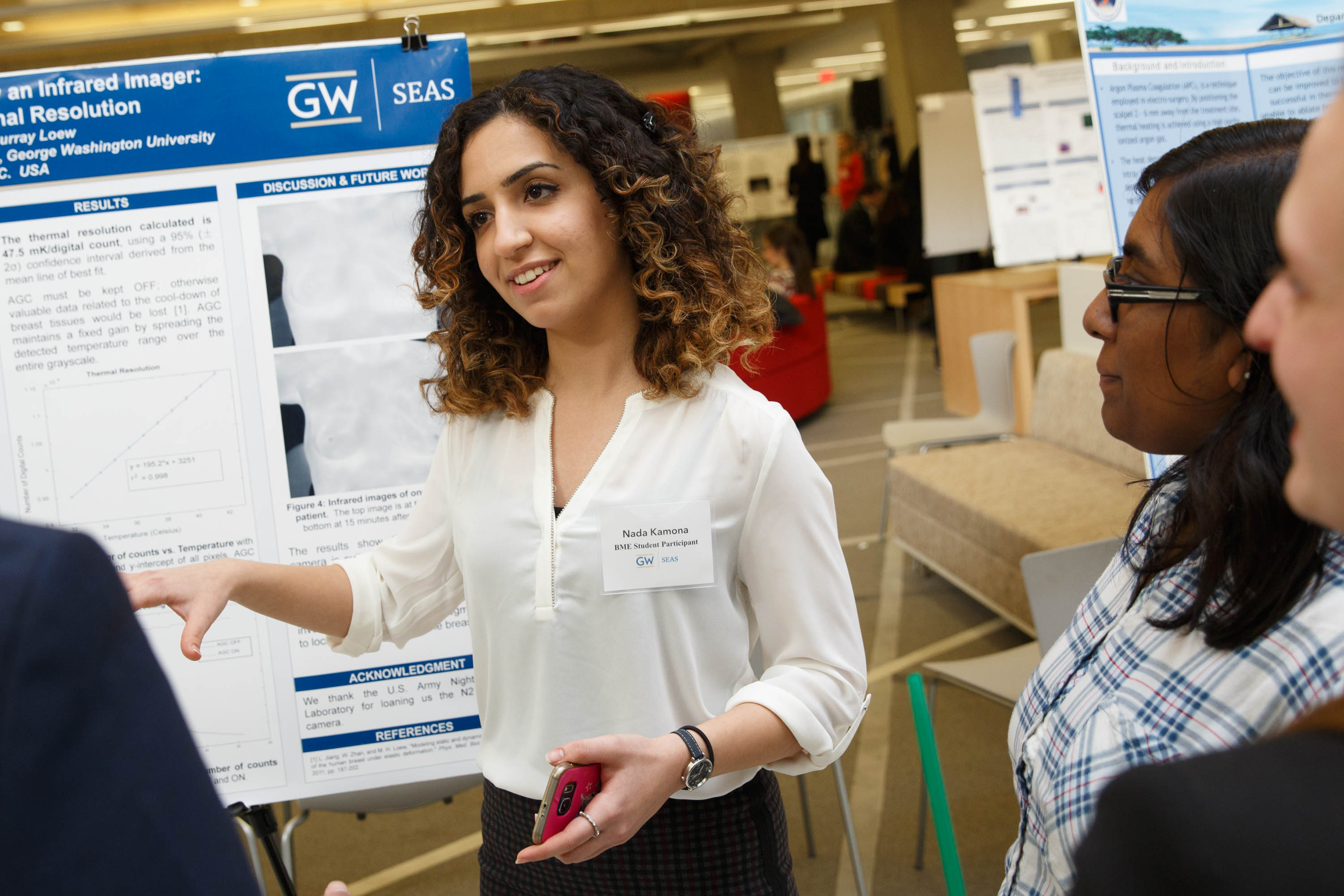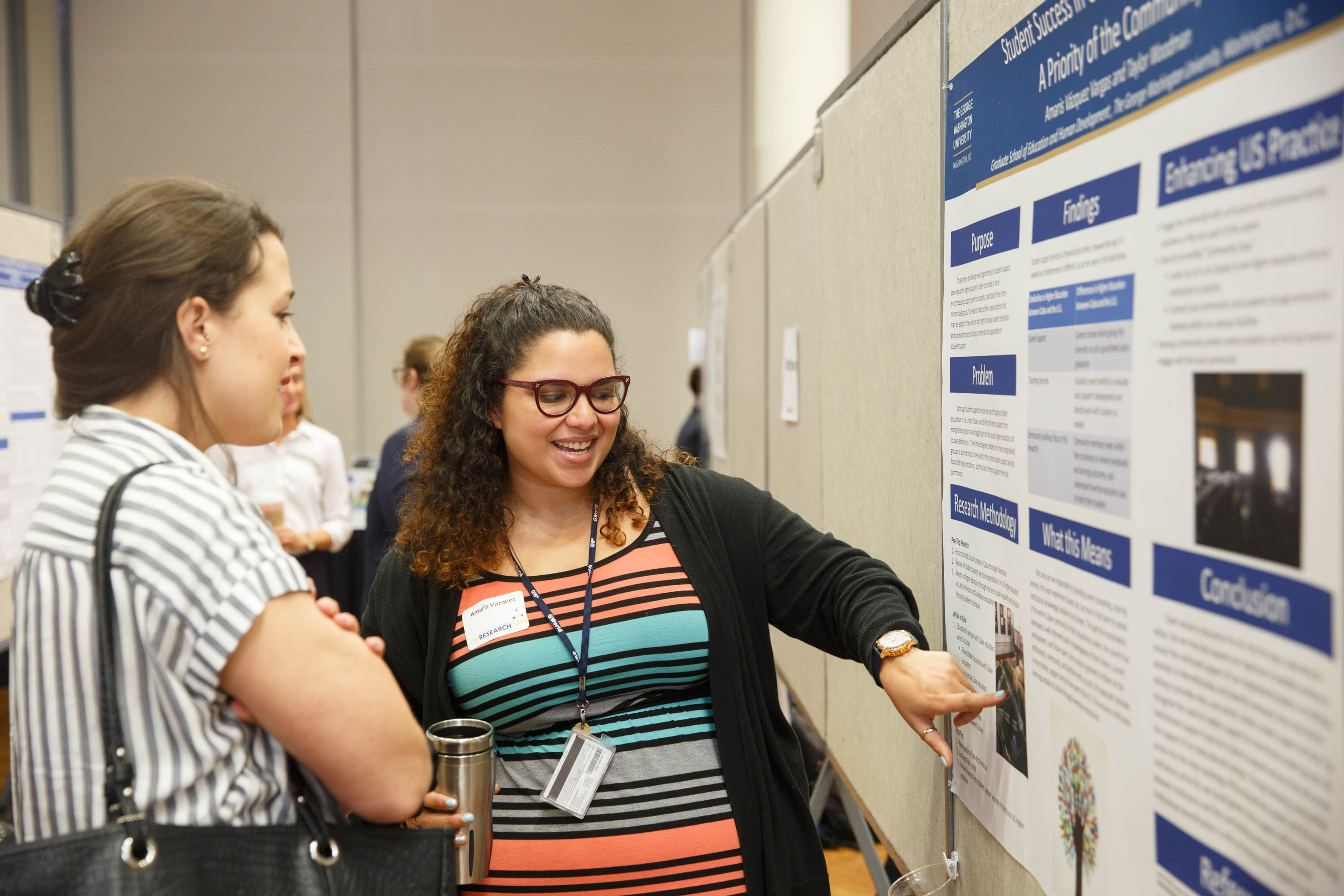By Kristen Mitchell
George Washington University researchers presented novel ideas ranging from a new method to treat cancer to a wearable device that can warn of heart complications during the 2017 Innovation Competition, sponsored by the Technology Commercialization Office within the Office of the Vice President for Research.
The Wednesday competition focused on commercialization potential, featuring innovations that could be impactful or profitable in the marketplace. GW students, faculty and staff showcased 12 posters focused on life sciences and nine physical science posters, all of which were evaluated by a panel of experienced entrepreneurs, investors and industry professionals.
A finalist and runner-up named for both categories were awarded $30,000 total in prizes.
“Each year our inventions are stronger and more diverse,” said Steve Kubisen, managing director of the Technology Commercialization Office. “GW researchers’ ability to have significant impact on our economy and healthcare is truly remarkable."
James Clessuras, a partner at the Washington, D.C., law firm Wilson Sonsini Goodrich and Rosati, gave a talk about issuing licenses at university-based start-ups. He leads the office’s technology transactions practice.
GW Today gathered some of the promising ideas from this year’s competition:
Making sustainable graphite
GW Department of Chemistry researchers Nathan Banek, Dustin Abele, Kevin McKenzie and Associate Professor Michael Wagner were awarded the first place physical science award for their research “Graphite from Biomass: Sustainable Route to Highest Purity and Lowest Price in a $14 billion Market.”
The demand for graphite—commonly used in batteries— has been rising over the last decade. Mining for graphite creates significant pollution, said Dr. Banek, and mines around the world have been forced to close. Experts foresee shortages of petcoke, a synthetic graphite replacement and oil processing byproduct, as consumption of high quality graphite in Li-ion batteries grows.
GW researchers came up with an inexpensive synthetic graphite replacement. The synthetic material comes from the bio-char byproduct when plants are used to create bio-oil. The synthetic graphite is estimated to cost about the same amount as natural unprocessed graphite. The team was awarded $10,000 to advance the development of their invention.
Improving drug development pipeline
Aleksandra Klimas and Professor Emilia Entcheva, researchers in the School of Engineering and Applied Science, were awarded the first place prize for life science technologies and $10,000 for their research “OptoDyCe: an All-Optical High Throughput Platform for Personalized Medicine and Drug Screening.”
They proposed a streamlined process that would get drugs to the marketplace faster by improving failure prediction early in the pipeline. Currently it takes about 12 years for a drug to advance from pre-clinical trials to market approval, said Ms. Klimas, a Ph.D. student. They would do this through population or patient-specific testing and better toxicity prediction.
The OptoDyCe screen is a method and device that monitors electrical activity in the heart and would provide better indication of drug toxicity before clinical trials. The OptoDyCe could examine 10,000 cell samples per day— a feat that would take one person 20 years, Ms. Klimas said.
Measuring technology development
SEAS Department of Electrical and Computer Engineering researchers Shuai Sun, Vikram Narayana, Abdel-Hameed Badawy, Tarek El-Ghazawi and faculty mentor Volker Sorger placed second in the physical science category for their project “Hybrid Photonic-Plasmonic Interconnect (HyPPI): Tracing Moore’s Law in a CLEAR Way.”
The project proposes the first holistic measure, coined Capability to Latency Energy Amount Resistance (CLEAR), to accurately benchmark the performance of computer advancements while taking communication delay, energy efficiency and scaling into account.
The method accurately tracked technology developments since the 1940s, a sign it could effectively predict future evolution. The team was awarded $5,000.
Fighting cancer
Alejandro Villagra, assistant professor in the School of Medicine and Health Sciences, presented "Enhancing Immunotherapy Through Selective Inhibition of Histone Deacetylase 6" and placed second in the life sciences category. The project was awarded $5,000.
Dr. Villagra proposed a method of using the body’s natural processes to fight cancer instead of turning to common techniques like chemotherapy. By using HDAC inhibitors, which can limit gene expression, survival odds for cancer patients could improve dramatically, Dr. Villagra said.
“Cancer is a big problem in the world, we have been for 200 years trying to fight cancer with no success,” he said Wednesday. “In the last few years as we found out, what if instead of fighting cancer we empower our own immune system to fight cancer.”
A ring that detects heart attacks
SEAS Associate Professor Zhenyu Li developed a wearable device that monitors electrical activity in the heart via a discrete ring that alerts family members or a physician if abnormalities are detected.
The ring, through constant contact with the skin, can be a daily replacement for a traditional electrocardiogram, which is expensive and requires a hospital visit. This device could be potentially life saving for the 364,000 Americans die from heart attacks every year.
“One-third of those heart attacks have been at home or outside of a medical facility,” Dr. Li said.
If an abnormal heart rate is detected, a read out of the EKG could be sent to select individuals who could read the EKG if they are trained or call the wearer. If the wearer does not pick up, they could call emergency services for help.




